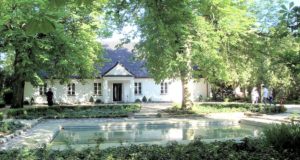
Łazy Palace Estate: The Chopin Connection
 The Łazy Palace Estate in Kampinos (sold) - The Łazy Palace estate is an opportunity to own a part of the Chopin family heritage. It includes a 311 m², 12-room wing of a 19th-century palace on 4.37 ha of enclosed park land and has potential for commercial redevelopment as a hotel, resort, or performance center, drawing on its proximity to the Chopin birthplace museum in Żelazowa Wola and the estate’s links with the Chopin and Skarbek families. Łazy lies just south of Kampinos National Park, 20 km from Poland’s new air hub, and 40 km west of Warsaw.
The Łazy Palace Estate in Kampinos (sold) - The Łazy Palace estate is an opportunity to own a part of the Chopin family heritage. It includes a 311 m², 12-room wing of a 19th-century palace on 4.37 ha of enclosed park land and has potential for commercial redevelopment as a hotel, resort, or performance center, drawing on its proximity to the Chopin birthplace museum in Żelazowa Wola and the estate’s links with the Chopin and Skarbek families. Łazy lies just south of Kampinos National Park, 20 km from Poland’s new air hub, and 40 km west of Warsaw.
There were strong ties between the Chopins, the Skarbeks, and the Bromirski family that resided at the Łazy Palace, with just a gentle stretch of farmland separating Łazy from the Skarbek family estate in Żelazowa Wola, where Fryderyk Chopin was born in 1810.
It is for this reason that Łazy constitutes a stop on the “Chopin Route” cultural trail that has been created through a joint project of the Mazovian regional government and the EU’s European Regional Development Fund, with the goal of helping visitors from around the world to follow in the footsteps of the great Polish pianist and composer.
The Bromirski family, the Skarbeks, and the Chopins
The founder of the Łazy Palace estate was the much-decorated royal official and wealthy landowner Onufry Bromirski (1740-1834), who was well known as a patron of culture who hosted lively dinners for artists and writers every Sunday. Bromirski was the son of Marianna Skarbek (ca. 1710 – after 1753) of the Abdank coat of arms, the daughter of a kasztelan and senator of the Polish-Lithuanian Commonwealth.
While Marianna’s son Onufry established his home in Łazy, her nephew Kacper Skarbek acquired his own estate in the neighboring village of Żelazowa Wola. Around the year 1800, Kacper his wife Ludwika invited the French-born tutor Nicolas Chopin to move to their manor in Żelazowa Wola, to serve as governor to their four children. In 1806, Nicolas married Justyna Krzyżanowska, who managed the Skarbek’s household and whose parents were impoverished members of the nobility. Justyna had herself been born on an estate belonging to the Skarbek family in the village of Długie, where her father had served as administrator of the Skarbeks’ properties, and it is possible that Justyna herself may have enjoyed some distant family ties with the Skarbeks. The Chopin and Skarbek families became quite close, sometimes travelling and vacationing together.

In 1810, the Chopins’ second child, Fryderyk, was born in the Skarbek manor house in Żelazowa Wola. Their employers’ son, Fryderyk Skarbek – whom Nicolas had once tutored – served as the godfather of the infant Fryderyk Chopin. Years later, Chopin’s first published composition, a polonaise, would be dedicated to Wiktoria Skarbek, the younger sister of (later Count) Fryderyk Skarbek, and the Skarbeks likely covered the work’s printing costs themselves.
The creator of the Łazy Palace estate was thus a first cousin of the family that employed the Chopins and a first cousin once removed of Fryderyk Chopin’s godfather, friend, and artistic champion, Fryderyk Skarbek. The occupants of Łazy Palace, the Skarbeks, and the Chopin family were essentially neighbors within early 19th-century Sochaczew county, and the Chopin family passed through Łazy whenever travelling back and forth between Warsaw and Żelazowa Wola upon the ancient Royal Route that crossed Mazovia. Moreover, it is known from a letter that Fryderyk Chopin wrote to his close friend Tytus Woyciechowski in 1830 that even after moving away from Żelazowa Wola, he long maintained relations with members of the Bromirski family that owned the Łazy Palace estate, and they periodically dropped in to visit Chopin in Warsaw.
Łazy’s connections with the Chopin family is commemorated in the three-kilometer-long Fryderyk Chopin Memorial Linden Avenue that leads from Łazy to the crossroads in the nearby village of Zawady, whose church contains tombs of some members of the Bromirski family. The avenue is lined by 765 linden trees, 11 ash trees, and one oak that in summer turn the route into a spectacular verdant tunnel that is ideal for a relaxing bicycle ride or stroll. Along the side of the avenue stands a shrine dedicated to St. Roch that was built by Władysław Bromirski, an heir of the founder of the Łazy Palace estate.
Łazy’s contemporary place in the world of Chopiniana
In many ways, the history of the Łazy Palace estate mirrors the history of the nearby manor house or dwór in which Fryderyk Chopin was born. Chopin’s parents dwelt in the left oficyna or auxiliary wing of the manor house. The main section of the dwór burned in 1812, and the right oficyna was destroyed during the First World War. However, the portion of the structure in which Fryderyk was born survives, and today it is part of a park and museum dedicated to the composer that constitute a place of pilgrimage for Chopin-lovers from around the globe. The lovingly restored oficyna retains much of its original traditional Mazovian architecture, along with other elements like a double-columned portico that were added in later eras. Today, Łazy Palace awaits redevelopment by a visionary investor who wishes to become a part of this rich historical tapestry.
